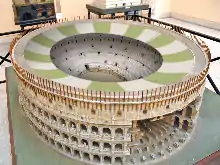Velarium
A velarium ("curtain")[1] was a type of awning used in Roman times. It stretched over the whole of the cavea, the seating area in amphitheaters to protect spectators from the sun.[2] [3]Precisely how the awning was supported is a matter of conjecture.[4][5]
_01.jpg.webp)

History
Retractable awnings were relatively common throughout the Roman Empire, including on the wooden amphitheater that preceded the Colosseum.[3]
The Colosseum
The Colosseum being the biggest amphitheater of roman times, the velarium that covered it was the biggest that ever was as well. It provided shade from the sun for up to one third of the arena. The velarium also created a ventilation updraft, creating circulation and a cool breeze.
It is believed that sailors, with their background in sailmaking and rigging were employed to build, maintain and operate the velarium.
In modern times
The Puy du Fou theme park, in France, has a roman-style amphitheatre built for some of its shows, complete with an antique-style velarium.
.jpg.webp)
.jpg.webp)
References
- Cf. velum, "veil, sail".
- "Awning at the Colosseum".
- "Was the Colosseum covered? The story of the Velarium". Through Eternity. 2019-02-29. Check date values in:
|date=(help) - Juvenal iv.121
- Suetonius, Life of Caligula 26 (Text).